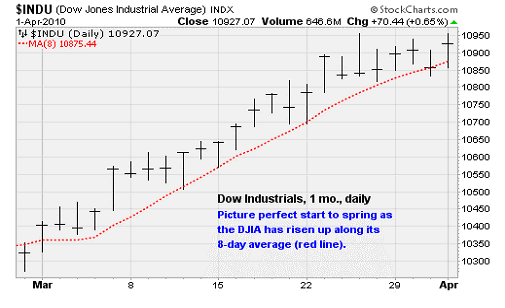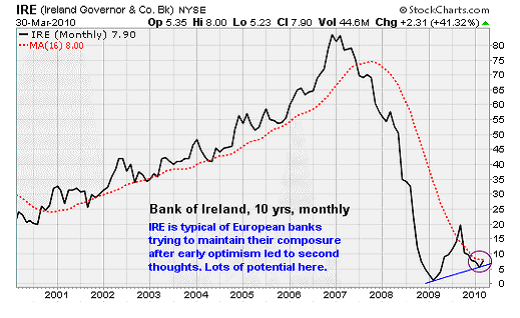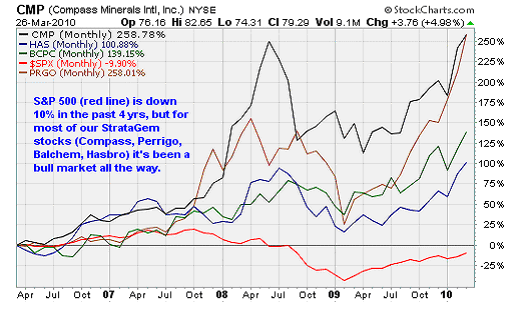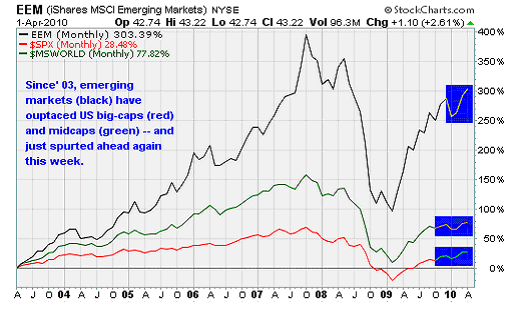Why the Stocks Bulls Can Stand Strong at Home and Overseas
Stock-Markets / Stock Markets 2010 Apr 05, 2010 - 06:07 AM GMTBy: Money_Morning
 Jon D. Markman writes: Stocks enjoyed another plus week, closing one of the better Marches of the past 80 years. It seems like ages since volatility has been this low, and there have been many complaints about complacency and listlessness. Yet those concerns may be misplaced if indeed we are enjoying the second leg of a normal bull cycle. Low volatility in a bearish phase does suggest complacency, to be sure, but in a bullish phase it serves more to keep expectations in check.
Jon D. Markman writes: Stocks enjoyed another plus week, closing one of the better Marches of the past 80 years. It seems like ages since volatility has been this low, and there have been many complaints about complacency and listlessness. Yet those concerns may be misplaced if indeed we are enjoying the second leg of a normal bull cycle. Low volatility in a bearish phase does suggest complacency, to be sure, but in a bullish phase it serves more to keep expectations in check.

Overseas large caps (VEU) were the stars of the week, as China jumped 8%, Russia jumped 7% and Europe rose 4%, far outpacing the 0.8% advance of major U.S. companies.
One special mover of note was the Bank of Ireland Group (NYSE ADR: IRE), which rose 30% in the past three days after the Irish government announced a broad slate of measures that essentially nationalized the country's financial institutions. It was the sort of "bad news is good news" release that clears the air on the banks' viability, while at the same time showing officials are finally ready to face up to lenders' mistakes.

IRE looks to be in line to win the "tallest midget" contest as it appears to have been the least worst of a bad lot; at least none of its officials have been arrested yet for fraud, which is not something that competitor Anglo Irish Bank can say. Plus you have to love a ticker symbol that is so combative.
The dollar was weaker, bonds weakened, gold yawned, politics took a bite out of health care and natural gas inched back above $4. The world has basically quieted down for a few weeks, with no major outbreaks of fear, elation, heat, cold or war -- even in South Korea, where a naval warship sank a week ago.
It's as if investors are heeding the courage of U.S. flag officer David Farragut in the Battle of Mobile Bay during the Civil War, who called out from his perch in the rigging of the USS Hartford after the sinking of a sister ship: "Damn the torpedoes, full speed ahead!" (Historical note: They didn't actually have self-propelled torpedoes back in 1864; that was the word used for tethered mines.)
Either this is a lull before the storm, or the world is settling into the pace of a normal economic recovery. With first-quarter earnings reporting season straight ahead in the next four weeks, it looks to me like the latter. Year-on-year comparisons are going to be spectacular, and forward guidance is likely to be as positive as we heard recently from Best Buy Co., Inc. (NYSE: BBY), NIKE, Inc. (NYSE: NKE) and The Boeing Co. (NYSE: BA).
Earlier in the year, I was expecting a much more jagged first half for 2010 but the stupendous amount of fiscal spending and cheap money has so far served to grease the skids for bulls. Think about it: Interest rates hit historic lows near zero last year, and have stayed there for a year. Then the largest non-wartime government spending package was passed last year, and augmented this year, and only about 35% of the money has been spent.
Some of that money will be misspent and be siphoned off by corrupt officials and overpaid executives, but those guys are the most likely to actually go on spending sprees -- so it's not all bad, it gets recycled into the economy. Many U.S. state governments are in budget trouble, but since most way overspent in boom times the current deficit crunch they're enduring should be seen as a healthy scare; they won't default.
Credit investors, who tend to be more sophisticated than equity investors, have seen these cues and bid up corporate debt to levels that are the equivalent of 1,400 in the S&P 500. Since equity virtually always follows credit, often through a circuitous path, we can expect most major U.S. stocks to get back to their early 2008 levels at the very least, which is where the S&P 500 was last at 1,400.
If that sounds preposterous, then consider that many, many major stocks are already at that level or far beyond. And I'm not talking about no-name small-caps. IBM Corp. (NYSE: IBM) may have flat-lined for the past three months, but don't forget it has blasted past its 2007 highs and has left the bear market in the dust. So has Nike. So have Amazon.com (Nasdaq: AMZN) and Apple Inc. (Nasdaq: AAPL).

So have more than half the stocks on my recommended list of the past month, comprising five different industries (tech, toys, drugs, chemicals and business services): F5 Networks, Inc. (Nasdaq: FFIV), Hasbro, Inc. (NYSE: HAS), Perrigo Co. (Nasdaq: PRGO), Balchem Corp. (Nasdaq: BCPC) and Cognizant Technology Solutions Corp. (Nasdaq: CTSH).
The interesting thing about all this is that few people seem to be treating this as a regular bull market. Most fund managers who have a choice were underweight stocks during the first quarter in anticipation of trouble from the overbought condition of late 2009 and fears of rising U.S. interest rates and the Fed's exit from the mortgage market. Now they are underperforming their bogeys, and warming to the notion that they can stand to have more exposure to risk.
This nervousness in the face of strength is a common example of the wall of worry that all bull markets surmount. My point is that while the U.S. market is overbought at the moment, which means it is likely to either slip or go sideways for a couple of weeks, it is otherwise in bull mode, so don't get shaken out of your positions.
I hate to sound like a Pollyanna, but I'll just say this anyway: So long as the Fed and European Central Bank continue to make lots of money available via low interest rates, and the governments keep printing and spending it, and companies are using their bond-market money to buy back stock and buy competitors, and consumers aren't sitting on their hands, then every dip for the next few years is likely to be a buying opportunity. Eventually all the debt that will be accumulated in this cycle will lead to the market's demise - but that is a worry for another day.
New Optimism for Emerging Markets
Last week we discussed the tactical reasons to be cautious on the emerging market economies. These came courtesy of Credit Suisse analyst Alexander Redman, who spent some quality time on the road meeting with clients. While he said he found a "great deal of evidence'' to structurally support the asset class longer-term, he said he also found "significant shorter term constraints.''
Now we take a look at the long-term reasons to still be bullish on the incredible growth story unfolding in places like China and India. Remember that up until 200 years ago these two great nations housed the two latest economies in the world.

Now, they are poised to retake their position at the top of the chart. Here are 9 reasons Redman is strategically optimistic:
-- Emerging markets now account for over half of global GDP (based on purchasing power parity) and can now take over as the driver of global growth since they are far less indebted than the developed economies.
-- Corporate, household, and government balance sheets in the emerging markets are in much better shape than in the developed world.
-- EM economies still retain significant potential for productivity gains as workers become more educated and more skilled while the capital base becomes more modernized.
-- Superior demographics in the EM economies (i.e., lots of young people and high birth rates).
-- Rising consumption, particularly in non-Japan Asia and the Persian Gulf.
-- Rapid urbanization and significant infrastructure growth.
-- Equalization of living standards, healthcare, and drug spending in the EM economies compared to the developed world.
-- Potential for growth in EM capital markets as new equity and debt issues are released while government investment restrictions are relaxed.
-- Significant potential for upward revaluation of EM currencies, especially China. Foreign currency appreciation will bolster the U.S. dollar denominated returns of foreign holdings for American investors.
Nick Cashmore, a top analyst at CLSA Asia Pacific Markets in Jakarta, told Reuters that the advance in Indonesia recently did not make the stocks overvalued. "It still has the opportunity to grow," he said, citing strength in domestic demand and commodity prices across the resource-rich Indonesian archipelago.
Data released on Thursday showed Indonesia's annual inflation slowing in March to a below-forecast 3.4%, Reuters said, adding to its aura as an emerging market darling due to low rates, subdued inflation, strong growth and political stability.
Eventually IDX and its peers around Southeast Asia, including Thailand (THD) and Malaysia (EWM) will rise into bubble territory, but that is almost certainly at least a year away. You always want to be a part of a bubble while it is happening; too much money is left on the table if you try to leave early. Stay with Indonesia for now.
The Week in Review
Monday: Personal income was flat in February after rising 0.3% in January. But this didn't dampen shopping spirits. Consumption posted a 0.3% rise, building on a 0.4% increase in January. Still, much of the increase was due to higher gasoline prices.
Tuesday: Consumer confidence improved in March, rising to 52.5 compared to the 46 reading in February. This was ahead of the consensus estimate of 50 and is inline with the previous four-month average of 51.8. The "jobs hard to get" sub index fell to 45.8 for the best reading since August as the employment situation continues to improve. The largest positive in the report was the 7.3 point gain in the expectations component to 70.2.
Separately, the Case-Shiller Home Price Index for January indicated continued stabilization for the housing market with a 0.4% month-over-month price increase.
Wednesday: Stocks moved lower in early trading today after investors were shaken by a weaker-than-expected ADP employment report. It stated that private industry payrolls dropped by another 23,000 in March; analysts expected at least a 50,000 advance.
The ADP report offers a preview of the benchmark employment situation report compiled by the Bureau of Labor Statistics, which also includes federal, state and municipal payrolls. The good news is that the ADP numbers don't properly account for the swing factor from weather (which weighed on February's job numbers but is expected to benefit those in March) as well as government hiring.
Thursday: The manufacturing sector continues to strengthen as the ISM Manufacturing Index increased to 59.6 in March from 56.5 in February. This was also ahead of the consensus estimate of 56.3. Any reading over 50 indicates an expansion in activity. While new orders and production remain strong, the big swing factor was an increase in inventories in March -- an indication that managers are finally feeling optimistic enough about the economic environment to initiate restocking.
Friday: The big March employment situation report was released and it was a good one. The economy added 164,000 jobs, but the unemployment rate remained unchanged at 9.7%. The private sector (ex government) added an impressive 162,000 jobs. Of these, nearly a quarter came from the goods producing sector -- a fantastic sign that American manufacturers are roaring back to life.
In summary, the March numbers are consistent with a gradually improving labor market, but hardly one bounding back to health. The headline gain was at the 42nd percentile of changes since 1950. But this is actually good news since it will allow the Federal Reserve to maintain its easy policy stance for longer without fear of a rapid drop in the unemployment rate triggering an incipient rise in inflation.
The Week Ahead
Monday: The ISM Non-Manufacturing Index will provide a read on the important services sector of the economy. Analysts expect another month of growth with the consensus estimate increasing to 54 in March from the 53 result for February. There is good reason for this, with the leading new orders sub index rising to 55 in February for the best month-to-month growth since August 2007.
Tuesday: The meeting minutes from the latest Federal Reserve meeting will be released.
Wednesday: Consumer credit report will provide a look at the indebtedness of American households. Credit outstanding increased by $5 billion in January -- breaking a record run of 11 consecutive months of declines. January's jump was the result of an increase of non-revolving credit tied to car loans and the like. Revolving credit card debt still dropped by $1.7 billion.
Thursday: March chain store sales and weekly initial jobless claims will be released.
Friday: Data on February wholesale trade will be released.
Source: http://moneymorning.com/2010/04/05/bull-market-3/
Money Morning/The Money Map Report
©2010 Monument Street Publishing. All Rights Reserved. Protected by copyright laws of the United States and international treaties. Any reproduction, copying, or redistribution (electronic or otherwise, including on the world wide web), of content from this website, in whole or in part, is strictly prohibited without the express written permission of Monument Street Publishing. 105 West Monument Street, Baltimore MD 21201, Email: customerservice@moneymorning.com
Disclaimer: Nothing published by Money Morning should be considered personalized investment advice. Although our employees may answer your general customer service questions, they are not licensed under securities laws to address your particular investment situation. No communication by our employees to you should be deemed as personalized investent advice. We expressly forbid our writers from having a financial interest in any security recommended to our readers. All of our employees and agents must wait 24 hours after on-line publication, or 72 hours after the mailing of printed-only publication prior to following an initial recommendation. Any investments recommended by Money Morning should be made only after consulting with your investment advisor and only after reviewing the prospectus or financial statements of the company.
Money Morning Archive |
© 2005-2022 http://www.MarketOracle.co.uk - The Market Oracle is a FREE Daily Financial Markets Analysis & Forecasting online publication.



